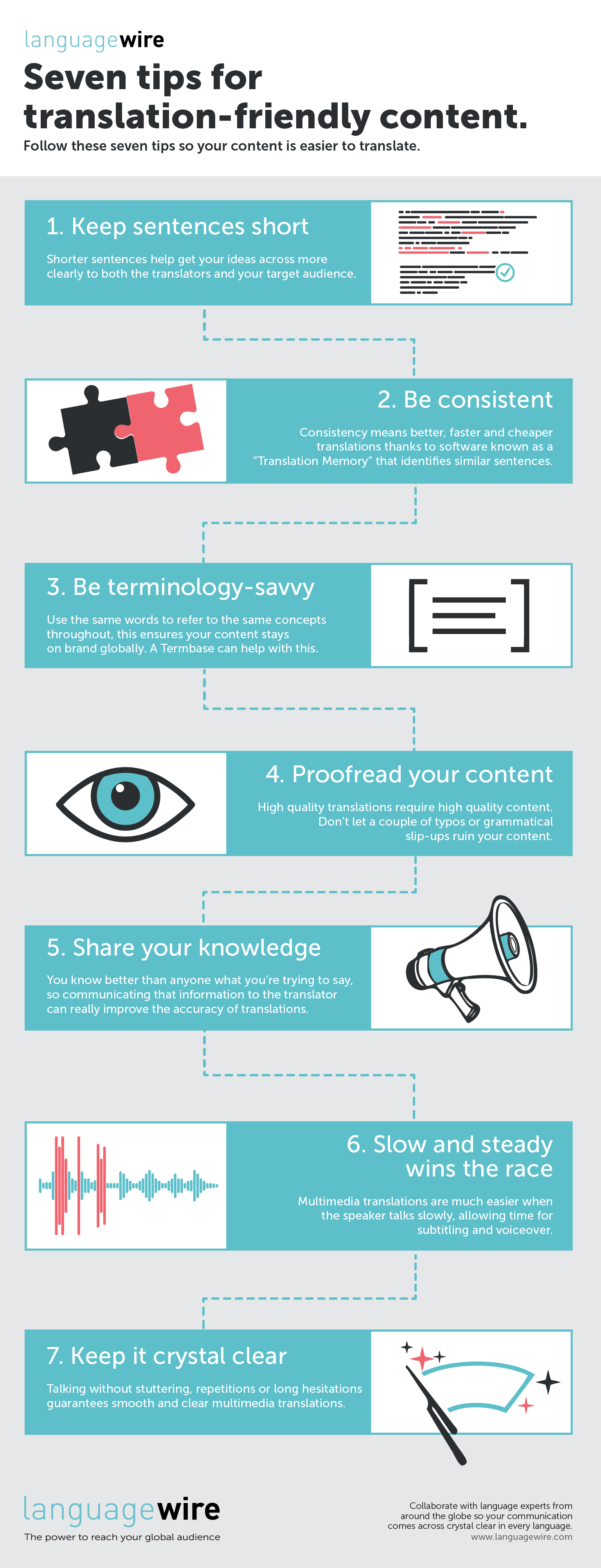With increasing pressure to reach consumers globally, it becomes all-the-more important to write translation-friendly content. While it's tempting to use your favourite idioms or poetic grammatical structures, these can often become stumbling blocks in the process of translation. Therefore, we’ve written down our top tips on how to make your content flow as seamlessly as possible into other languages.
1. Keep sentences short

Simplicity is key! Longer sentences are more difficult to translate and can cause clunky and unnatural translations. Shorter sentences increase clarity for all. Not only will your translators thank you, but your readers will find your content more readable.
Sentence length is one of the most essential factors for readability. Writing simpler sentences ensures that your work is more easily understood across all languages. This is one of the best tips for guaranteeing high quality and engaging multilingual content. So keep your sentences short and sweet!
2. Be consistent

Shorter sentences facilitate writing that is more consistent. But there are more techniques you can use to maintain consistency. If you have recurring sentences in your translations, it's best to try to keep the wording and grammatical structure the same throughout. The familiar format makes it an easier read for your audience and a better, faster, cheaper translation for you.
How does it make translation cheaper you ask? Modern Language Service Providers (LSPs) incentivise consistency through the use of Translation Memories. This is a tool that automatically searches and reuses words, sentences, and entire texts that have already been translated. Here at LanguageWire, we offer discounts on previously translated sentences. Smaller "segments" are easier to match, easier to translate, and therefore save you more money!
3. Be terminology-savvy

Make sure the same term is used to refer to the same concept throughout your document production. This principle can be at odds with our ingrained schooling to dig out a synonym from the thesaurus whenever the same word is used more than once. However, you don't need to boast about your depth of vocabulary to consumers as if they are your Year 11 English teacher. Rather, regular terms will enable your translators to provide consistent target-language content and will improve your texts' readability.
For example, translation is more straightforward when you avoid situations like: click "open", press "load project" and hit "start". Ideally, you keep it consistent by using the same verb for each action: click "open", click "load project" and click "start".
PRO TIP: You can keep a catalogue of your brand terms and send it to us. This information will form the backbone of your very own “Termbase”. We'll then populate it with the translations of each term and upload it to our online platform, where your translators and in-house validation team can easily access it. The Termbase can ensure uniformity in branding for your company across languages. For example, you could use it to guarantee that you were always referred to as a ‘business', and never as an ‘institution'. The Termbase gives you the power to manage your content on brand, globally.
4. Proofread your content

Before you hand over your content to your translators, you should make sure it's in the best shape it can be. Translating texts that contain typos, grammar errors, or unclear sentences is difficult, and your translations will be more error-prone. When on a tight deadline, it can seem better to get your text to the translators ASAP. However, it is well worth the time ensuring the source content is written well. If you’re truly aiming for top-quality translations, you wouldn’t want the original content to let you down.
The easiest way to proofread your content is to include as part of an automated workflow. When using LanguageWire, we can create a workflow that includes proofreading of your source content before it is sent for translation. This method eliminates the hassle, helps keep your time-to-publish short, and your content great.
5. Share your knowledge

If you're the content writer (or someone closely involved in the process), you'll have valuable insights that can help translators. You know the thought process behind every sentence. You have in-depth knowledge of the subject matter. And you have a clear idea of what the aim of your content is. Your insight can make all the difference in carrying the precise style and meaning of your words into the other languages.
The more of this information you share with us, the closer our translations will be to your source content. Unlike other language service providers, through our platform, you can directly contact the language expert working on your content. This transparency helps projects run smoother and improves the quality of your content.
Bonus: Multimedia translations
Of course, all the above applies to multimedia translation, but here are a few extra tips for optimising multimedia content. Getting this done right during the initial stage of production can prevent serious issues when trying to reach your international audience.
6. Slow and steady wins the race

Ask the people who appear in the video to speak a bit more slowly than they normally would. For subtitling, you want to give your viewers as much time as possible to read the on-screen text. Likewise, for recording a voiceover, you want to allow enough time so that the voiceover experts don't have to rush. Given that translation often has an expanding effect (i.e. concepts can take more words to explain in other languages), it is important to be generous with timings.
7. Keep it crystal clear

Speakers should try to deliver the message as clearly as possible. Mumbling, hesitations and repetitions make it much harder to provide clear translations for your multimedia content. This problem cannot be easily controlled during unscripted productions like interviews. However, it's best when possible to speak in full sentences carefully articulating each word.

